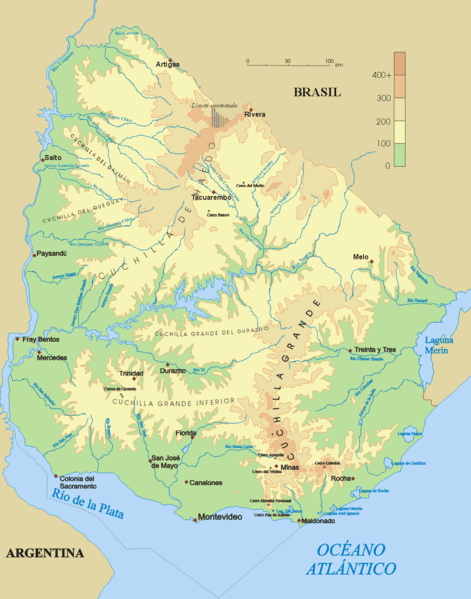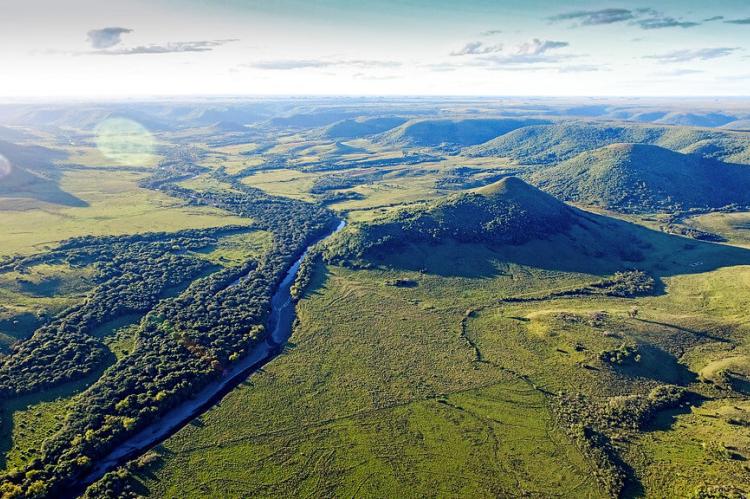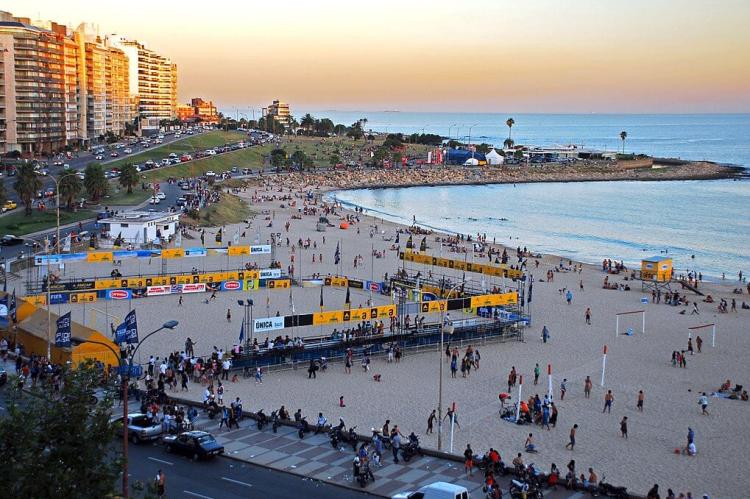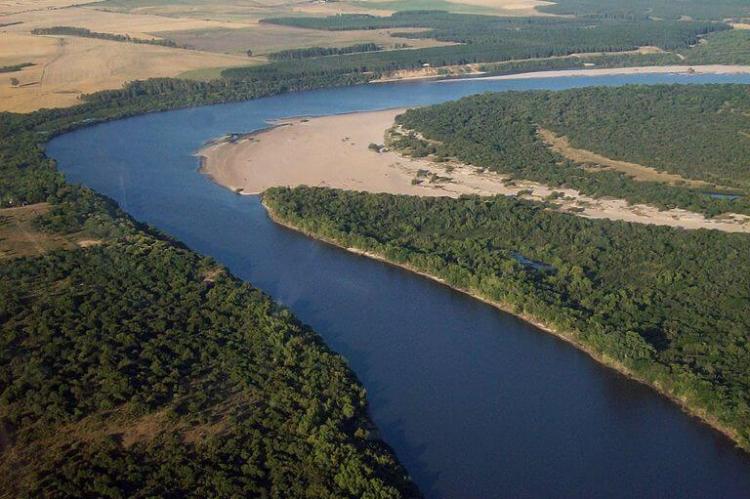Water Bodies of Uruguay
Water bodies have played a significant role in shaping Uruguay's geography, economy, and cultural identity. The Río de la Plata and Atlantic coastline are essential for trade, commerce, and tourism, while the Uruguay River and freshwater lagoons are vital resources in biodiversity and agriculture.
Water Bodies of Uruguay
Despite being smaller than its neighboring countries, Uruguay has important bodies of water that play significant roles in shaping its geography, economy, and cultural identity. The Río de la Plata and the Atlantic coastline are essential gateways to the sea, serving as vital connections for trade, commerce, and tourism. These coastal regions are home to Uruguay's pristine beaches and vibrant seaside towns, significantly contributing to its tourism industry and cultural allure.
Inland, the Uruguay River and freshwater lagoons provide invaluable resources for sustaining regional biodiversity, agriculture, industry, and human consumption. They are also an essential part of the country's border with Argentina, symbolizing both a natural boundary and a bridge between nations.
Despite their modest scale, Uruguay's water bodies are integral to the rhythm of daily life, providing resources for livelihoods, inspiration for cultural expression, and avenues for recreation and relaxation. They leave an indelible mark on the nation's identity.
Aquifer
Guaraní Aquifer System: The Guaraní Aquifer System (GAS) is a large natural underground groundwater reservoir and hydrogeological system. It is a transboundary aquifer spread across four South American countries: Argentina, Brazil, Paraguay, and Uruguay. The primary use of the aquifer is for drinking water supply, but there are also industrial, agricultural irrigation, and thermal tourism uses.
Bays and Estuaries
Río de la Plata (River Plate): The Río de la Plata is a massive estuary shared by Argentina and Uruguay. It forms a natural border between the two countries and is one of the most expansive rivers in the world. The river's mouth opens into the Atlantic Ocean, creating a vast bay known for its muddy brown color caused by sediment deposition.
Bay of Montevideo (Bahía de Montevideo): The Bay of Montevideo is a natural harbor along the southern coast of Uruguay's capital city, Montevideo. It is one of the most important bays in Uruguay and plays a crucial role in the city's maritime and economic activities. The bay's deep waters allow for the docking of large cargo ships and cruise liners, contributing to Montevideo's position as a major port city in the region.
Notable Rivers
Uruguay River (Río Uruguay): The Uruguay River forms part of the border between Uruguay and Argentina. It is one of the largest rivers in South America and is approximately 1,600 km (994 mi) long. The river begins at the confluence of the Pelotas River and Canoas River in Brazil and flows southward, dividing Uruguay from Argentina. The Uruguay River is essential for transportation, hydroelectric power generation, and tourism.
Black River (Río Negro): The Río Negro is one of the major rivers in Uruguay. It originates in Brazil and flows through the country before eventually joining the Uruguay River. The river is essential for agriculture, irrigation, and supporting local ecosystems.
Santa Lucía River (Río Santa Lucía): The Santa Lucía River is notable in southern Uruguay, flowing through the departments of Canelones and San José. It is an essential water source for the capital city, Montevideo, and its surroundings.
Yi River (Río Yi): The Río Yi is located in central Uruguay, flowing through the departments of Durazno and Florida. It is used for irrigation and supports local agriculture.
Tacuarembo River (Río Tacuarembó): The Tacuarembó River is located in the northern part of Uruguay and flows through the department of Tacuarembó. It is an important river for agriculture and livestock activities in the region.
Arapey River (Río Arapey): The Arapey Riover is situated in the department of Salto in northwestern Uruguay. It is known for its hot springs and is a popular destination for tourists seeking relaxation.
Cebollatí River (Río Cebollatí): The Cebollatí River is located in southeastern Uruguay, forming part of the border with Brazil. It flows through the department of Rocha and plays a role in the region's ecology.

Topographical map of Uruguay.
Notable Lakes and Lagoons
Laguna del Sauce: Located near Punta del Este, Laguna del Sauce is the largest coastal lagoon in Uruguay. It offers a picturesque setting surrounded by rolling hills and provides water-based activities such as fishing, boating, and birdwatching opportunities.
Laguna Garzón: Situated on the eastern coast of Uruguay, Laguna Garzón is a shallow coastal lagoon separated from the Atlantic Ocean by a sandbar. It is known for its scenic beauty and attracts visitors seeking tranquility and natural surroundings.
Laguna de Rocha: Found in the department of Rocha, Laguna de Rocha is a coastal lagoon near La Paloma. It is a critical wetland habitat for various bird species, making it a popular destination for birdwatching and ecotourism.
Laguna de Castillos: Located in the department of Rocha, Laguna de Castillos is another coastal lagoon known for its natural beauty and birdlife. It is surrounded by lush vegetation and dunes, offering a serene environment for visitors.
Laguna Negra: Situated in the department of Maldonado, Laguna Negra is a small coastal lagoon nestled amid dunes and pine forests. It is part of the protected area of the Cerro Pan de Azúcar, providing a peaceful setting for nature lovers.
Laguna Merín: Laguna Merín is a large coastal lagoon shared between Uruguay and Brazil. It is the largest lagoon in South America and serves as a natural border between the two countries. The lagoon and its surroundings support diverse wildlife and are vital for local fisheries and tourism.
Laguna de José Ignacio: Located near José Ignacio in Maldonado, Laguna de José Ignacio is a coastal lagoon with tranquil waters and sandy beaches. It offers a relaxed environment for beachgoers and water sports enthusiasts.
Notable Dams and Reservoirs
Rincón del Bonete Dam and Reservoir: This is one of the most significant dams in Uruguay. It is located on the Rio Negro and forms the Rincón del Bonete Reservoir, the largest reservoir in the country. The dam primarily serves for hydroelectric power generation.
Baygorria Dam and Reservoir: Located on the Santa Lucía River, the Baygorria Dam forms the Baygorria Reservoir. The dam plays a role in water supply, flood control, irrigation, and hydroelectric power generation.
Palmar Dam and Reservoir: Situated on the Río Negro, the Palmar Dam creates the Palmar Reservoir. The reservoir has multiple purposes, including hydroelectric power generation and flood control.
Gabriel Terra Dam and Reservoir: Located on the Río Negro, this dam forms the Gabriel Terra Reservoir. It is another example of a dam used for multiple purposes, including water supply, power generation, and flood control.
India Muerta Dam and Reservoir: Positioned on the Santa Lucía River, this dam forms the India Muerta Reservoir. The dam plays a role in water management and flood control.





